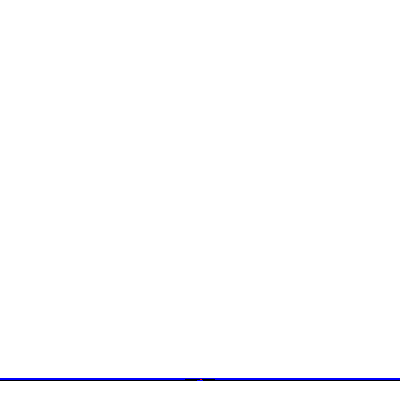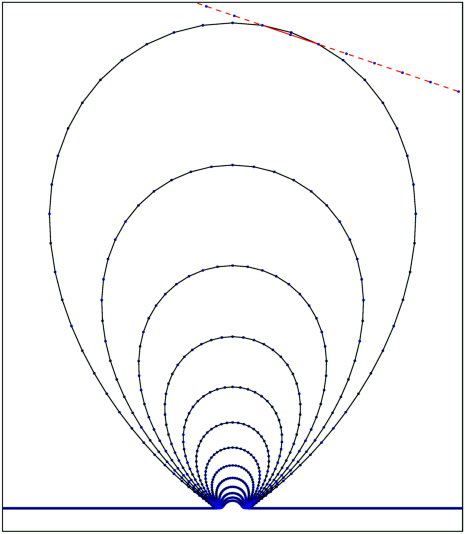An Inflating Bubble in Chaotic Inflation
 The animation at left shows a small region of space which starts to
inflate because it is a peak of the initially random inflaton field.
The small red line segment shows the size of the observable Universe,
which ends up being much smaller than the inflating bubble. As a result,
the observable Universe appears to be homogenous, isotropic and flat even
though Universe is actually inhomogeneous, anisotropic and curved.
The initial state could be curled up into a ball before the bubble starts
to grow in which case the Universe would actually be finite even though
inflation has made the bubble it contains
millions of times bigger than the observable
Universe.
The animation at left shows a small region of space which starts to
inflate because it is a peak of the initially random inflaton field.
The small red line segment shows the size of the observable Universe,
which ends up being much smaller than the inflating bubble. As a result,
the observable Universe appears to be homogenous, isotropic and flat even
though Universe is actually inhomogeneous, anisotropic and curved.
The initial state could be curled up into a ball before the bubble starts
to grow in which case the Universe would actually be finite even though
inflation has made the bubble it contains
millions of times bigger than the observable
Universe.
 The image on the right shows how the
inflating bubble evolves over 13 time steps covering a factor of 64 in
linear expansion. The y-axis in these diagrams is not time - this is
not a space-time diagram. Instead, the y-axis is a non-physical
coordinate used to make enough room for the great expansion of the size
of the bubble. A solid red line segment indicating the maximum
allowable size of the observable Universe is shown, but since we
actually think that inflation expanded the size of the Universe by a
factor of more than 1,000,000,000,000,000,000,000,000,000,000 instead
of the illustrated factor of 64, the actual size of the observable
Universe should be much smaller relative to the size of the bubble than
what I can illustrate here. Even so, a flat approximation to the
Universe shown by the dashed red line drawn as a chord across the
observable Universe is an excellent match to all the observations. The
large deviations between the dashed part of the red curve and the black
curve are of course outside the observable Universe and thus not
observable. Calculations in the flat model are much simpler and very
accurate over the observable Universe. In the chaotic inflation model
there are many such inflating bubbles randomly distributed through
space. Each bubble is effectively a Universe in its own right. There
is no possibility of communicating from one bubble to another, since
all communications have to be along the curve because the y-axis is not
a real spatial dimension in this graph. Light can only travel a short
distance along the curve -- this distance determines the size of our
observable Universe. Thus the existence and properties of any other
bubbles are more the subject of metaphysics than astrophysics. But if
a model makes distinctive predictions about our observable Universe,
which are confirmed by precise observations, then the model should be
taken seriously even if it predicts unobservable other bubbles.
The image on the right shows how the
inflating bubble evolves over 13 time steps covering a factor of 64 in
linear expansion. The y-axis in these diagrams is not time - this is
not a space-time diagram. Instead, the y-axis is a non-physical
coordinate used to make enough room for the great expansion of the size
of the bubble. A solid red line segment indicating the maximum
allowable size of the observable Universe is shown, but since we
actually think that inflation expanded the size of the Universe by a
factor of more than 1,000,000,000,000,000,000,000,000,000,000 instead
of the illustrated factor of 64, the actual size of the observable
Universe should be much smaller relative to the size of the bubble than
what I can illustrate here. Even so, a flat approximation to the
Universe shown by the dashed red line drawn as a chord across the
observable Universe is an excellent match to all the observations. The
large deviations between the dashed part of the red curve and the black
curve are of course outside the observable Universe and thus not
observable. Calculations in the flat model are much simpler and very
accurate over the observable Universe. In the chaotic inflation model
there are many such inflating bubbles randomly distributed through
space. Each bubble is effectively a Universe in its own right. There
is no possibility of communicating from one bubble to another, since
all communications have to be along the curve because the y-axis is not
a real spatial dimension in this graph. Light can only travel a short
distance along the curve -- this distance determines the size of our
observable Universe. Thus the existence and properties of any other
bubbles are more the subject of metaphysics than astrophysics. But if
a model makes distinctive predictions about our observable Universe,
which are confirmed by precise observations, then the model should be
taken seriously even if it predicts unobservable other bubbles.
FAQ |
Tutorial :
Part 1 |
Part 2 |
Part 3 |
Part 4 |
Age |
Distances |
Bibliography |
Relativity
© 2003-2004
Edward L. Wright. Last modified 18 Oct 2004
 The animation at left shows a small region of space which starts to
inflate because it is a peak of the initially random inflaton field.
The small red line segment shows the size of the observable Universe,
which ends up being much smaller than the inflating bubble. As a result,
the observable Universe appears to be homogenous, isotropic and flat even
though Universe is actually inhomogeneous, anisotropic and curved.
The initial state could be curled up into a ball before the bubble starts
to grow in which case the Universe would actually be finite even though
inflation has made the bubble it contains
millions of times bigger than the observable
Universe.
The animation at left shows a small region of space which starts to
inflate because it is a peak of the initially random inflaton field.
The small red line segment shows the size of the observable Universe,
which ends up being much smaller than the inflating bubble. As a result,
the observable Universe appears to be homogenous, isotropic and flat even
though Universe is actually inhomogeneous, anisotropic and curved.
The initial state could be curled up into a ball before the bubble starts
to grow in which case the Universe would actually be finite even though
inflation has made the bubble it contains
millions of times bigger than the observable
Universe.
 The image on the right shows how the
inflating bubble evolves over 13 time steps covering a factor of 64 in
linear expansion. The y-axis in these diagrams is not time - this is
not a space-time diagram. Instead, the y-axis is a non-physical
coordinate used to make enough room for the great expansion of the size
of the bubble. A solid red line segment indicating the maximum
allowable size of the observable Universe is shown, but since we
actually think that inflation expanded the size of the Universe by a
factor of more than 1,000,000,000,000,000,000,000,000,000,000 instead
of the illustrated factor of 64, the actual size of the observable
Universe should be much smaller relative to the size of the bubble than
what I can illustrate here. Even so, a flat approximation to the
Universe shown by the dashed red line drawn as a chord across the
observable Universe is an excellent match to all the observations. The
large deviations between the dashed part of the red curve and the black
curve are of course outside the observable Universe and thus not
observable. Calculations in the flat model are much simpler and very
accurate over the observable Universe. In the chaotic inflation model
there are many such inflating bubbles randomly distributed through
space. Each bubble is effectively a Universe in its own right. There
is no possibility of communicating from one bubble to another, since
all communications have to be along the curve because the y-axis is not
a real spatial dimension in this graph. Light can only travel a short
distance along the curve -- this distance determines the size of our
observable Universe. Thus the existence and properties of any other
bubbles are more the subject of metaphysics than astrophysics. But if
a model makes distinctive predictions about our observable Universe,
which are confirmed by precise observations, then the model should be
taken seriously even if it predicts unobservable other bubbles.
The image on the right shows how the
inflating bubble evolves over 13 time steps covering a factor of 64 in
linear expansion. The y-axis in these diagrams is not time - this is
not a space-time diagram. Instead, the y-axis is a non-physical
coordinate used to make enough room for the great expansion of the size
of the bubble. A solid red line segment indicating the maximum
allowable size of the observable Universe is shown, but since we
actually think that inflation expanded the size of the Universe by a
factor of more than 1,000,000,000,000,000,000,000,000,000,000 instead
of the illustrated factor of 64, the actual size of the observable
Universe should be much smaller relative to the size of the bubble than
what I can illustrate here. Even so, a flat approximation to the
Universe shown by the dashed red line drawn as a chord across the
observable Universe is an excellent match to all the observations. The
large deviations between the dashed part of the red curve and the black
curve are of course outside the observable Universe and thus not
observable. Calculations in the flat model are much simpler and very
accurate over the observable Universe. In the chaotic inflation model
there are many such inflating bubbles randomly distributed through
space. Each bubble is effectively a Universe in its own right. There
is no possibility of communicating from one bubble to another, since
all communications have to be along the curve because the y-axis is not
a real spatial dimension in this graph. Light can only travel a short
distance along the curve -- this distance determines the size of our
observable Universe. Thus the existence and properties of any other
bubbles are more the subject of metaphysics than astrophysics. But if
a model makes distinctive predictions about our observable Universe,
which are confirmed by precise observations, then the model should be
taken seriously even if it predicts unobservable other bubbles.